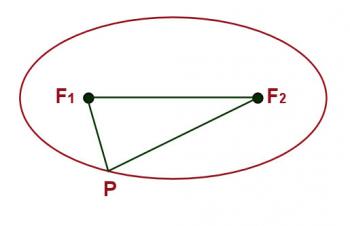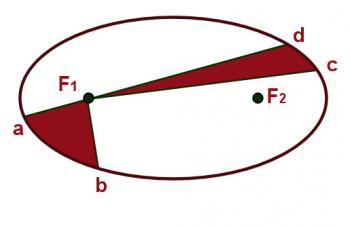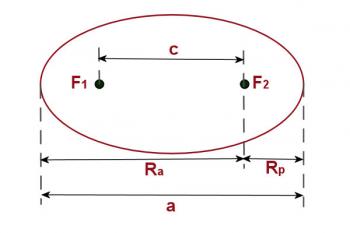Orbital Motion
Reference > Science > Physics > Study Guide > Unit 4: Kinematics 2 - Motion in Curved LinesOne common use of the concepts of uniform circular motion is in the study of orbital motion. Objects that are orbiting a central body such as satellites around the earth or planets around the sun follow three laws discovered by Kepler. They can be stated as follows:
- A radius vector drawn from the sun to a planet sweeps out equal areas in equal times.
- The planets follow elliptical orbits with the sun at one of the focus points.
- The ratio of the square of the period and the cube of the average radius is the same for all objects in a given planetary system.
Recall that an ellipse is a figure constructed in such a way that the sum of the two distances from any point on the perimeter of the ellipse to two fixed points, called focus points, is a constant.

Figure 4.3.1
Refer to figure 4.3.1. In the diagram f1and f2 are the two focus points. P is any point on the perimeter of the ellipse. The total distance from f1 to P and then to f2 is a constant. The distance between the focus points is labeled "c" and the line drawn from one end of the ellpise to the other through the focus points is the major axis, "a". The average radius of the orbit is oneâhalf the major axis. The eccentricity of the ellipse is defined asFigure 4.3.2 illustrates Kepler's first law, the law of areas. It shows a planet at 4 different points in its orbit. If the time elapsed as the object moves from a to b is the same as that which elapses as the object moves between points c and d then according to the first law the two shaded areas must be equal. This would indicate that the speed of the planet is greater between points a and b than it is between points b and c.

Figure 4.3.2
The point of closest approach to the sun is the perihelion distance (perigee if for an object orbiting the earth) and the most distant point is called the aphelion (apogee). It can be shown by application of Kepler's law of areas that the ratio of the aphelion speed to the perihelion speed is the inverse ratio of the the aphelion distance to the perihelion distance.
It can be shown that Kepler's third law is consistent with an inverse square law. That is how Newton was first led to his understanding that the force of gravity was inversely proportional to the square of the separation between two objects.
Much of the math dealing with elliptical orbits is beyond the scope of this course. We are pretty much limited to comparisons of greatest and smallest speeds for an orbiting object and a comparison of periods and radii for two objects in the same system. A couple of problems of this type are solved in the sample problem section. However, if the orbit of an object is nearly circular then the equations for circular motion can be combined with Newton's laws of motion and the law of gravity to calculate many of the orbit parameters. In many of the problems involving motion around the sun and Kepler's third law it is convenient to measure distances in AU (the average distance between the sun and the earth) and the time in years. When this is doneSample Problem #1
For the planet Mercury, the perihelion distance has been found to be 45.8 x 106 km, and the aphelion distance about 70.0 x 106 km. Calculate the eccentricity of the orbit of Mercury and the ratio of the maximum speed to the minimum speed.
Sample Solution #1

Figure 4.3.3
Examine figure 4.3.3. Since the focus points are symmetrically placed, it should be apparent that the length of the major axis,a, is rp + ra and the distance between the focus points, a, is rp - ra.
To find the eccentricity we have:a = 70.0 x106 + 45.8 x106
a = 115.8 x 106 km
c = 70.0 x 106 - 45.8 x 106
c = 24.2 x 106 km
e =
e =
e = 0.209
To find the ratio of the maximum speed to the minimum speed we take the ratio of the maximum distance to the minimum distance. However, be sure to note that the planet has the maximum speed when it is at the point of closest approach to the sun.
Sample Problem #2
Halley's comet has a period of 76yrs and its orbit has an eccentricity of 0.97
- What is its average distance from the sun.
- What is its greatest distance from the sun?
- What is its least distance from the sun?
- How does its greatest speed compare with its least speed?
Sample Solution #2
T2 = R3
762 = R3
The average radius is half the major axis, therefore the major axis, a is twice Ravg = 35.8 AU.
Since the eccentricity is 0.97 we can find the distance between the focus points, c, by using the definition of ecentricity:c = ea
c = 0.97(35.8)
c = 34.7AU
Rp =
Rp = 0.55 AU.
The furthest from the sun, Ra, will be
Sample Problem #3
Use the planetary data in appendix 2 and calculate the speed and period of the moon's orbit around the earth.
Sample Solution #3
ac =
F =
V = 1024
T =
T =
T = 2.3 x 107 sec
T = 26.6 days.
Questions
 Uniform Circular Motion
Uniform Circular Motion Unit Index
Unit Index

